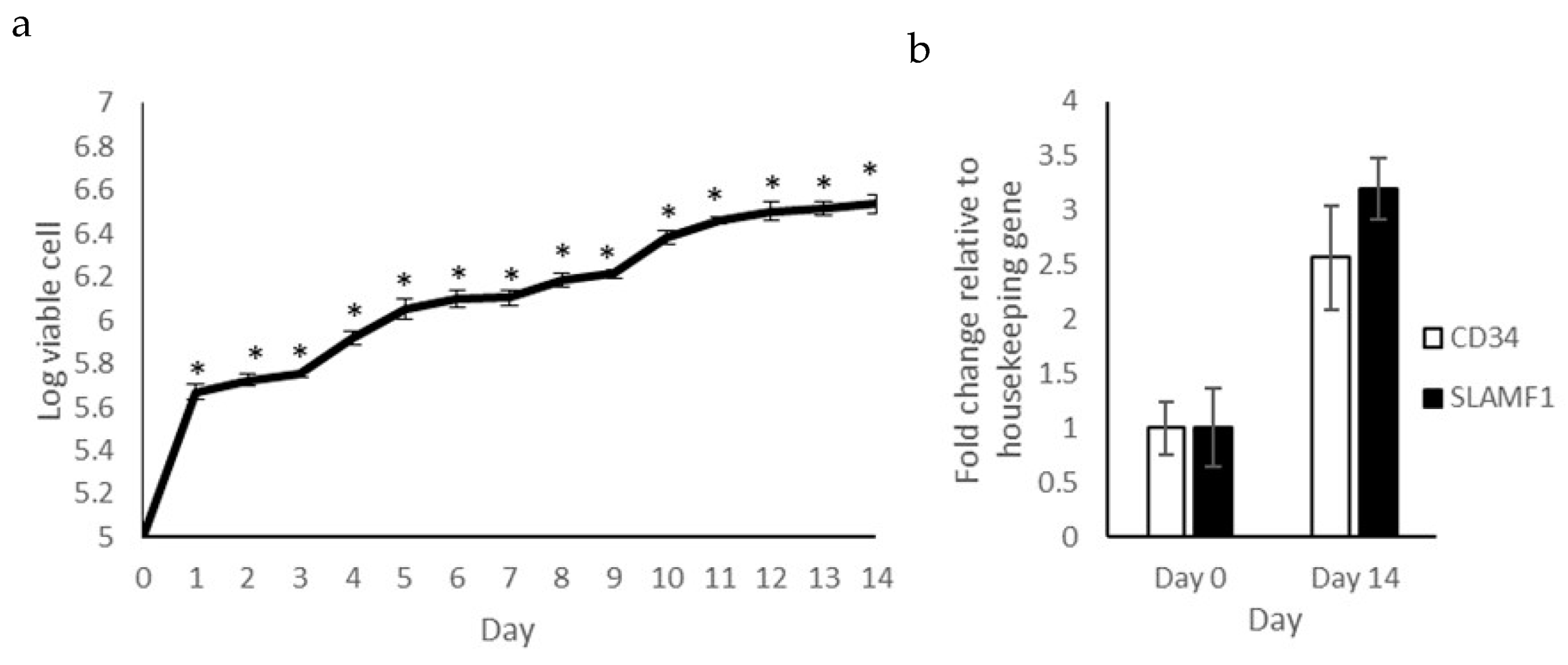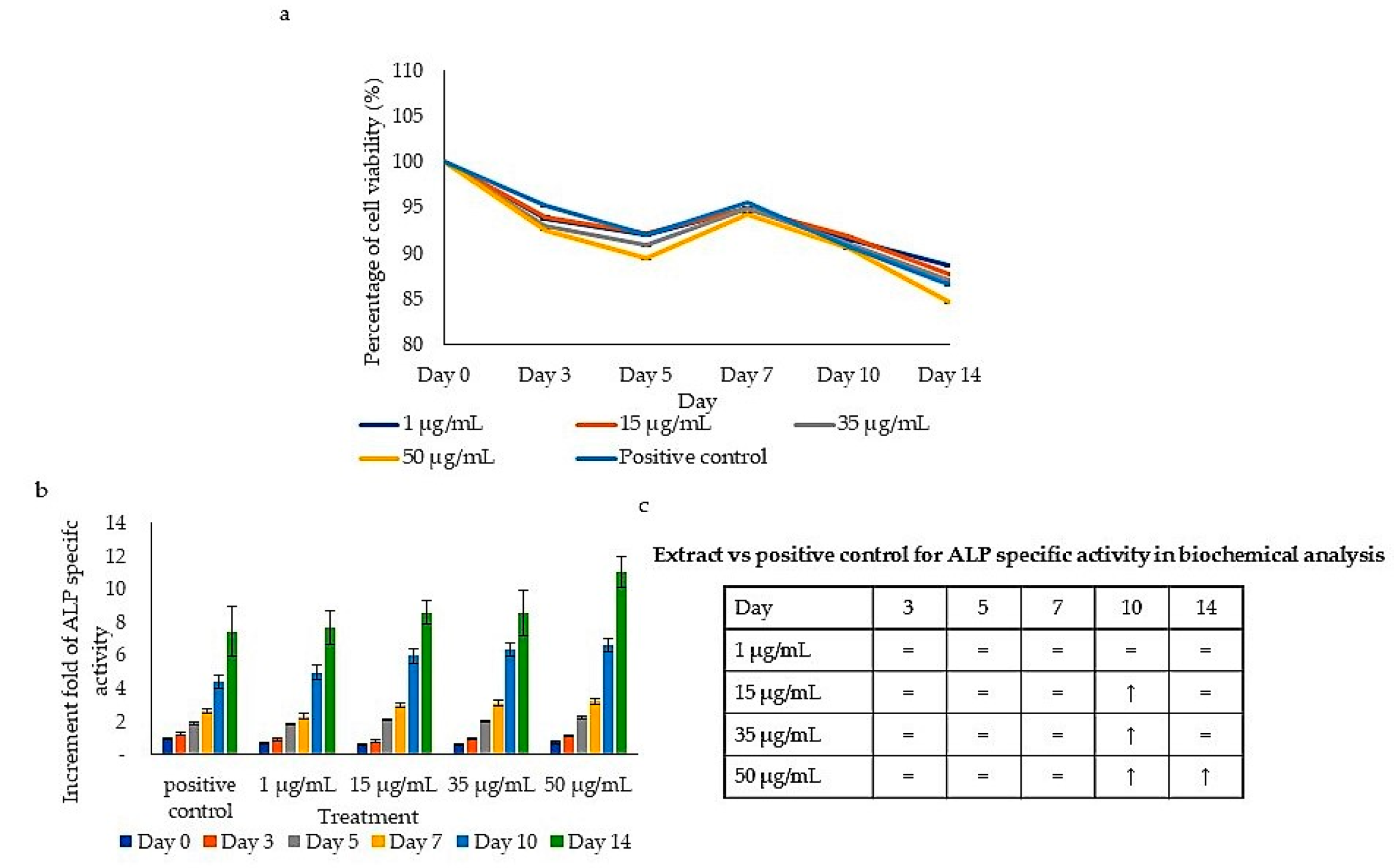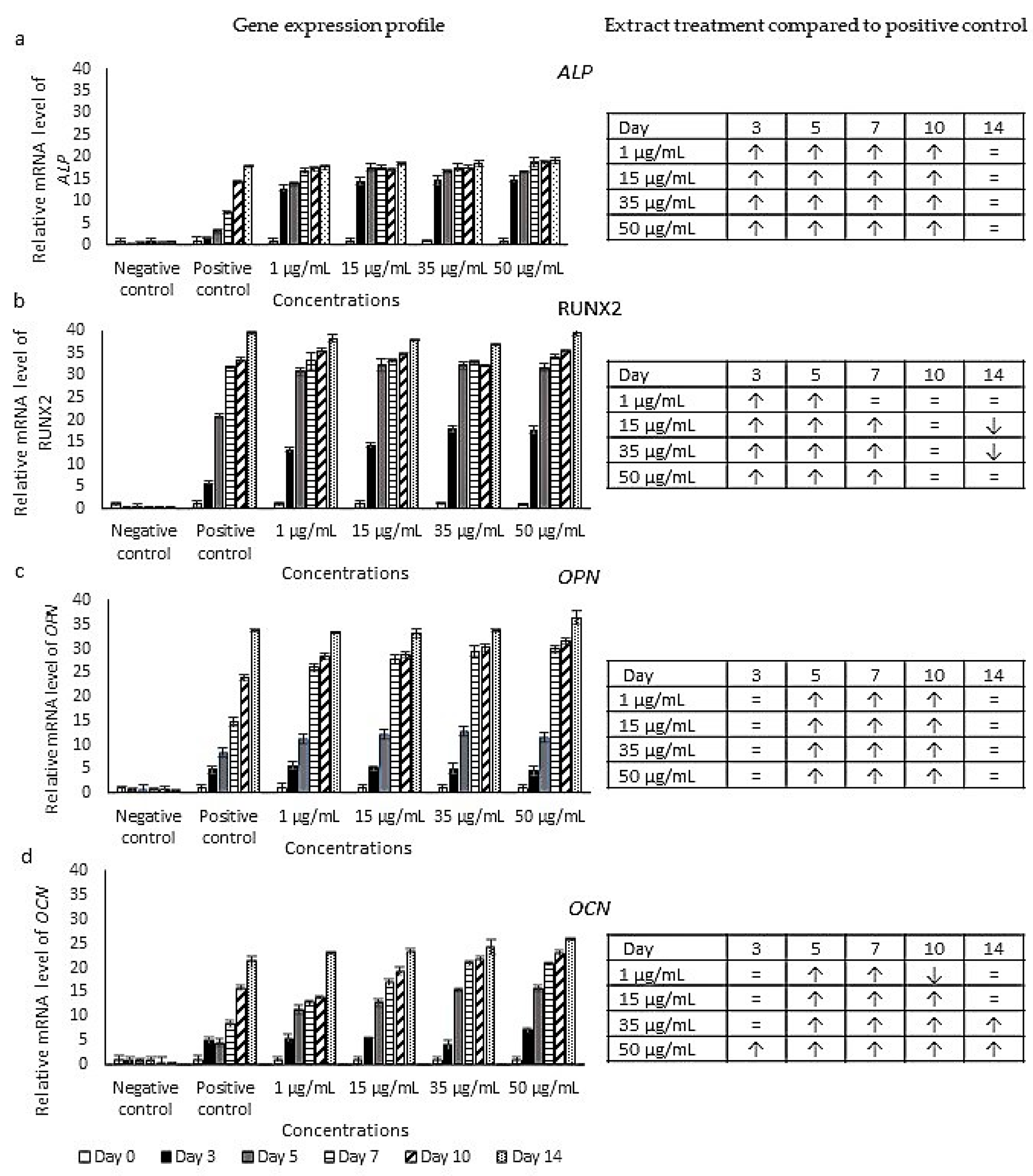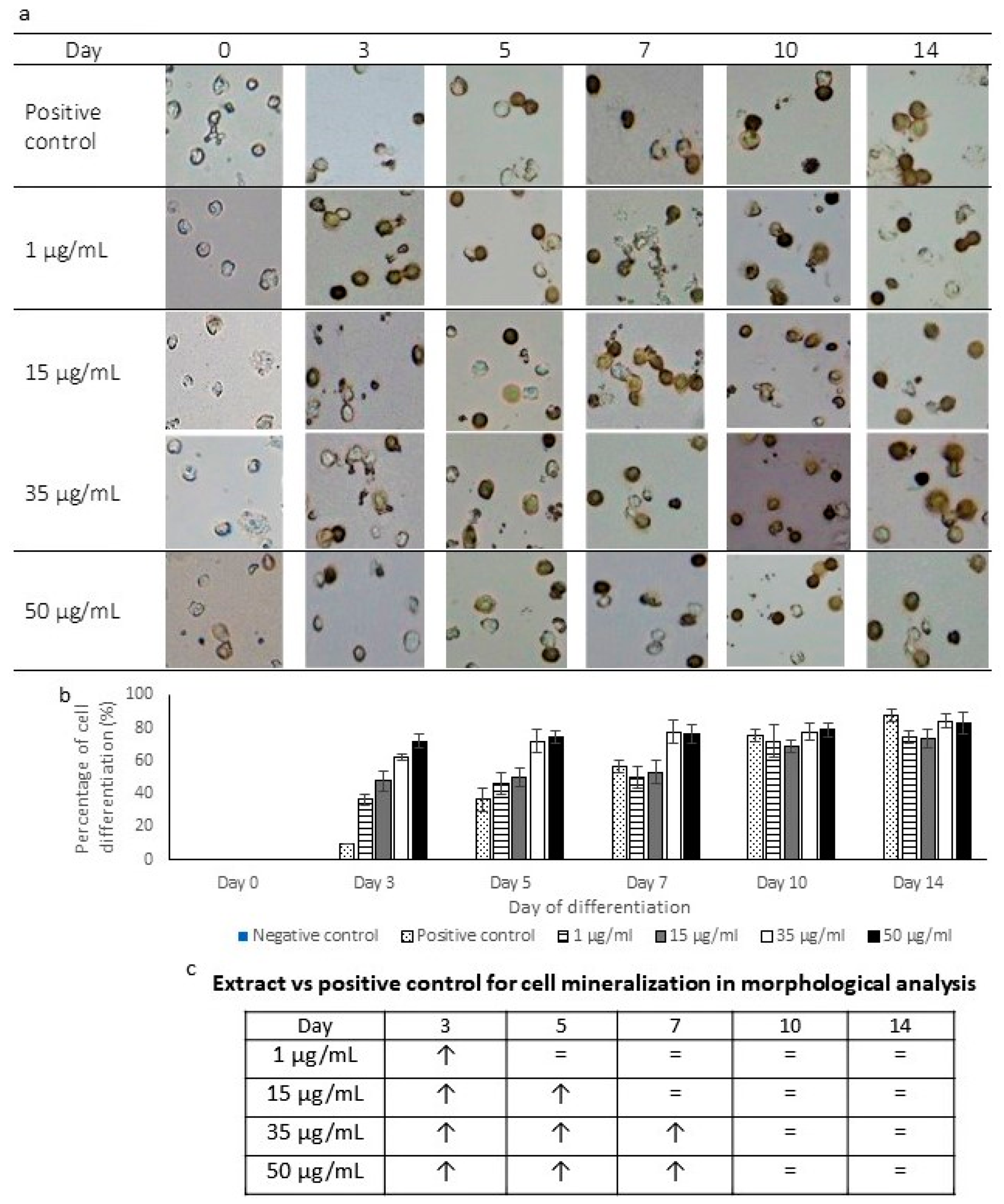Osteogenic Potential and Bioactive Profiles of Piper sarmentosum Ethanolic Extract-Treated Stem Cells
Abstract
:1. Introduction
2. Results
2.1. Proliferation Capacity and Expression of Hematopoietic Stem Cell Markers
2.2. Viability and ALP-Specific Activity during the Differentiation Assay
2.3. Expression Profiles of Osteoblast Markers
2.4. Morphology of Mineralized Cells
2.5. Compound Content in P. sarmentosum Ethanolic Extracts
3. Discussion
3.1. Stem Cell Characterization and Osteoblast Differentiation Induction
3.2. Compound and Biological Activity of Piper sarmentosum Ethanolic Extract
4. Material and Methods
4.1. Preparation of Plant Material
4.2. Collection, Isolation and Culture of Human Peripheral Blood Stem Cells
4.3. Proliferation Ability of the Isolated Cells
4.4. Molecular Characteristics of Hematopoietic Stem Cells
4.5. Induction of Osteoblast Differentiation Using P. sarmentosum Ethanolic Extract
4.6. Cell Viability of Differentiated Cells
4.7. Alkaline Phosphatase (ALP) Assay
4.8. Molecular Characteristics of Osteoblast Cells
4.9. von Kossa Staining
4.10. Gas Chromatography-Mass Spectrometry (GC-MS) and Compound Identification
4.11. Statistical Analysis
5. Conclusions
Author Contributions
Funding
Institutional Review Board Statement
Informed Consent Statement
Data Availability Statement
Conflicts of Interest
References
- Gibbons, S. An overview of plant extracts as potential therapeutics. Expert. Opin. Ther. Pat. 2003, 13, 489–497. [Google Scholar] [CrossRef]
- Yuan, H.; Ma, Q.; Ye, L.; Piao, G. The Traditional Medicine and Modern Medicine from Natural Products. Molecules 2016, 21, 559. [Google Scholar] [CrossRef] [PubMed]
- Hussain, K.; Hashmi, F.K.; Latif, A.; Ismail, Z.; Sadikun, A. A review of the literature and latest advances in research of Piper sarmentosum. Pharm. Biol. 2012, 50, 1045–1052. [Google Scholar] [CrossRef] [PubMed]
- Subramaniam, V.; Ilham Adenan, M.; Rashih Ahmad, A.; Sahdan, R. Natural antioxidants: Piper sarmentosum (Kadok) and Morinda elliptica (Mengkudu). Mal. J. Nutr. 2003, 9, 41–51. [Google Scholar]
- Rukachaisirikul, T.; Siriwattanakit, P.; Sukcharoenphol, K.; Wongvein, C.; Ruttanaweang, P.; Wongwattanavuch, P.; Suksamrarn, A. Chemical constituents and bioactivity of Piper sarmentosum. J. Ethnopharmacol. 2004, 93, 173–176. [Google Scholar] [CrossRef]
- Nguyen, N.H.; Nhi, T.T.Y.; Van Nhi, N.T.; Cuc, T.T.T.; Tuan, P.M.; Nguyen, D.H. Comparative Study of the Silver Nanoparticle Synthesis Ability and Antibacterial Activity of the Piper Betle L. And Piper Sarmentosum Roxb. Extracts. J. Nanomater. 2021, 2021, 5518389. [Google Scholar] [CrossRef]
- Zainol Abidin, I.Z.; Fazry, S.; Jamar, N.H.; Ediwar Dyari, H.R.; Zainal Ariffin, Z.; Johari, A.N.; Ashaari, N.S.; Johari, N.A.; Megat Abdul Wahab, R.; Zainal Ariffin, S.H. The effects of Piper sarmentosum aqueous extracts on zebrafish (Danio rerio) embryos and caudal fin tissue regeneration. Sci. Rep. 2020, 10, 14165. [Google Scholar] [CrossRef]
- Zin, N.N.I.N.M.; Khatap Munawwarah Omar Sul’ain, M.D.; Abu Bakar, N. Evaluation of antimalarial and toxicological activities of methanol and water leaves extracts of Piper sarmentosum. Asian J. Med. Biomed. 2019, 3, 19–24. [Google Scholar]
- Mohamad Asri, S.F.; Soelaiman, I.N.; Mohd Moklas, M.A.; Mohd Nor, N.H.; Mohd Ramli, E.S. The Role of Piper sarmentosum Aqueous Extract as a Bone Protective Agent, a Histomorphometric Study. Int. J. Mol. Sci. 2020, 21, 7715. [Google Scholar] [CrossRef]
- Estai, M.A.; Suhaimi, F.H.; Das, S.; Fadzilah, F.M.; Alhabshi, S.M.I.; Shuid, A.N.; Soelaiman, I.N. Piper sarmentosum enhances fracture healing in ovariectomized osteoporotic rats: A radiological study. Clinics 2011, 66, 865–872. [Google Scholar] [CrossRef]
- Feng, X.; Mcdonald, J.M. Disorders of Bone Remodeling. Annu. Rev. Pathol. Mech. Dis. 2011, 6, 121–145. [Google Scholar] [CrossRef]
- Chapurlat, R.D. Osteoporosis. In Endocrinology: Adult and Pediatric, 2-Volume Set, 7th ed.; Elsevier Inc.: Amsterdam, The Netherlands, 2016; pp. 1184–1213.e6. [Google Scholar] [CrossRef]
- Rodan, G.A.; Martin, T.J. Therapeutic approaches to bone diseases. Science 2000, 289, 1508–1514. [Google Scholar] [CrossRef]
- Ilyas, Z.; Camacho, P.M. Rare adverse effects of bisphosphonate therapy. Curr. Opin. Endocrinol. Diabetes Obes. 2019, 26, 335–338. [Google Scholar] [CrossRef]
- Chong, P.; Selvaratnem, L.; Abbas, A.; Kamarul, T. Human peripheral blood derived mesenchymal stem cells demonstrate similar characteristics and chondrogenic differentiation potential to bone marrow derived mesenchymal stem cells. J. Orthop. Res. 2012, 30, 634–642. [Google Scholar] [CrossRef]
- Muhammad Dain, Y.; Shahrul Hisham, Z.A.; Senafi, S.; Zaidah, Z.A.; Rohaya, M.A.W. Stem Cell Heterogeneity of Mononucleated Cells from Murine Peripheral Blood: Molecular Analysis. Sci. World J. 2011, 11, 2150–2159. [Google Scholar]
- Hadzir, S.N.; Ibrahim, S.N.; Abdul Wahab, R.M.; Zainol Abidin, I.Z.; Senafi, S.; Ariffin, Z.Z.; Razak, M.A.; Ariffin, S.H.Z. Ascorbic acid induces osteoblast differentiation of human suspension mononuclear cells. Cytotherapy 2014, 16, 674–682. [Google Scholar] [CrossRef]
- Ruzanna, A.K.; Ariffin, S.H.Z.; Wahab, R.M.A.; Senafi, S.; Huyop, F.Z. Differentiation potential of human suspension mononucleated peripheral blood cells. African J. Biotechnol. 2011, 10, 10756–10764. [Google Scholar] [CrossRef]
- Ruzanna, A.K.; Shahrul Hisham, Z.A.; Rohaya, M.A.W.; Kermani, S.; Sahidan, S. Characterization of mononucleated human peripheral blood cells. Sci. World J. 2012, 2012, 843843. [Google Scholar]
- Intan Zarina, Z.A.; Manogaran, T.; Rohaya, M.A.W.; Farinawati, Y.; Shahrul Hisham, Z.A. A Comparative Analysis of Ascorbic Acid-induced Cytotoxicity and Differentiation betwen SHED and DPSC. Curr. Stem Cell Res. Ther. 2022, 17, 576–588. [Google Scholar]
- Saravanakumar, K.; Ramkumar, B.; Muthuraj, V. In Vitro Antimicrobial Potential Efficiency of Clathria Frondifera Marine Sponge. Int. J. Res. Pharm. Chem. 2016, 6, 458–464. [Google Scholar]
- Togashi, N.; Shiraishi, A.; Nishizaka, M.; Matsuoka, K.; Endo, K.; Hamashima, H.; Inoue, Y. Antibacterial activity of long-chain fatty alcohols against Staphylococcus aureus. Molecules 2007, 12, 139–148. [Google Scholar] [CrossRef] [PubMed]
- Attia, H.; Harrathi, J.; Alamer, K.H.; Alsalmi, F.A.; Magné, C.; Khalil, M. Effects of nacl on antioxidant, antifungal, and antibacterial activities in safflower essential oils. Plants 2021, 10, 2809. [Google Scholar] [CrossRef] [PubMed]
- Choi, S.J.; Kim, J.K.; Kim, H.K.; Harris, K.; Kim, C.J.; Park, G.G.; Park, C.S.; Shin, D.H. 2,4-Di-tert-butylphenol from sweet potato protects against oxidative stress in PC12 cells and in mice. J. Med. Food. 2013, 16, 977–983. [Google Scholar] [CrossRef] [PubMed]
- Melappa, G.; Prakash, B. In vitro antimitotic, antiproliferative and GC-MS studies on the methanolic extract of endophytic fungi, Penicillium species of Tabebuia Argentea bur & K. Sch. Farm. 2017, 5, 301–309. [Google Scholar]
- Hematpoor, A.; Paydar, M.; Liew, S.Y.; Sivasothy, Y.; Mohebali, N.; Looi, C.Y.; Wong, W.F.; Azirun, M.S.; Awang, K. Phenylpropanoids isolated from Piper sarmentosum Roxb. induce apoptosis in breast cancer cells through reactive oxygen species and mitochondrial-dependent pathways. Chem. Biol. Interact. 2018, 279, 210–218. [Google Scholar] [CrossRef]
- Nikhila, G.; Sangeetha, G.; Preetha, T.; Swapna, T. GC-MS analysis of phytochemical compounds present in the rhizome of Gloriosa superba L. J. Pharmacogn. Phytochem. 2016, 5, 17–20. [Google Scholar]
- Nasir, N.A.H.A.; Roslly, N.A.L.; Rosli, N.M.; Razali, Z. Phytochemical Screening and Potential DPPH Radical Scavenging Activity of Banana Peel Extract. In Charting the Sustainable Future of ASEAN in Science and Technology 2; Springer: Singapore, 2020; pp. 249–258. [Google Scholar]
- Mou, Y.; Meng, J.; Fu, X.; Wang, X.; Tian, J.; Wang, M.; Peng, Y.; Zhou, L. Antimicrobial and Antioxidant Activities and Effect of 1-Hexadecene Addition on Palmarumycin C2 and C3 Yields in Liquid Culture of Endophytic Fungus Berkleasmium sp. Dzf12. Molecules 2013, 18, 15587–15599. [Google Scholar] [CrossRef]
- Turkez, H.; Celik, K.; Toghar, B. Effects of copaene, a tricyclic sesquiterpene, on human lymphocytes cells in vitro. Cytotechnology 2014, 66, 597–603. [Google Scholar] [CrossRef]
- Ferreira, R.; Monteiro, M.; Silva, J.; Maia, J. Antifungal Action of the Dillapiole-rich Oil of Piper aduncum against Dermatomycoses Caused by Filamentous Fungi. Br. J. Med. Med. Res. 2016, 15, 1–10. [Google Scholar] [CrossRef]
- Kumar, H.; Kim, B.W.; Song, S.Y.; Kim, J.S.; Kim, I.S.; Kwon, Y.S.; Koppula, S.; Choi, D.K. Cognitive enhancing effects of alpha asarone in amnesic mice by influencing cholinergic and antioxidant defense mechanisms. Biosci. Biotechnol. Biochem. 2012, 76, 1518–1522. [Google Scholar] [CrossRef]
- Lam, K.Y.; Chen, J.; Lam, C.T.; Wu, Q.; Yao, P.; Dong, T.T.; Lin, H.; Tsim, K.W. Asarone from Acori Tatarinowii Rhizoma Potentiates the Nerve Growth Factor-Induced Neuronal Differentiation in Cultured PC12 Cells: A Signaling Mediated by Protein Kinase A. PLoS ONE 2016, 11, e0163337. [Google Scholar] [CrossRef]
- Yang, Y.X.; Chen, Y.T.; Zhou, X.J.; Hong, C.L.; Li, C.Y.; Guo, J.Y. Beta-asarone, a major component of Acorus tatarinowii Schott, attenuates focal cerebral ischemia induced by middle cerebral artery occlusion in rats. BMC Complement. Altern. Med. 2013, 13, 236. [Google Scholar] [CrossRef]
- Faridha Begum, I.; Mohankumar, R.; Jeevan, M.; Ramani, K. GC–MS Analysis of Bio-active Molecules Derived from Paracoccus pantotrophus FMR19 and the Antimicrobial Activity Against Bacterial Pathogens and MDROs. Indian J. Microbiol. 2016, 56, 426–432. [Google Scholar] [CrossRef]
- Lee, Y.S.; Kang, M.H.; Cho, S.Y.; Jeong, C.S. Effects of Constituents of Amomum xanthioides on Gastritis in Rats and on Growth of Gastric Cancer Cells. Arch. Pharm. Res. 2007, 30, 436–443. [Google Scholar] [CrossRef]
- Naragani, K.; Mangamuri, V.; Muvva, S.; Munaganti, R.K. Antimicrobial potential of Streptomyces cheonanensis VUK-A from mangrove origin. Int. J. Pharm. Sci. 2016, 8, 53–57. [Google Scholar]
- Ceyhan-Guvensen, N.; Keskin, D. Chemical content and antimicrobial properties of three different extracts of Mentha pulegium leaves from Mugla Region, Turkey. J. Environ. Biol. 2016, 37, 1341–1346. [Google Scholar]
- Sanjeev, G.; Sidharthan, D.S.; Pranavkrishna, S.; Pranavadithya, S.; Abhinandan, R.; Akshaya, R.L.; Balagangadharan, K.; Siddabathuni, N.; Srinivasan, S.; Selvamurugan, N. An osteoinductive effect of phytol on mouse mesenchymal stem cells (C3H10T1/2) towards osteoblasts. Bioorg. Med. Chem. Lett. 2020, 30, 127137. [Google Scholar] [CrossRef]
- Matluobi, D.; Araghi, A.; Maragheh, A.; Rezabakhsh, A.; Soltani, S.; Khaksar, M.; Siavashi, V.; Feyzi, A.; Bagheri, H.S.; Rahbarghazi, R.; et al. Carvacrol promotes angiogenic paracrine potential and endothelial differentiation of human mesenchymal stem cells at low concentrations. Microvasc. Res. 2018, 115, 20–27. [Google Scholar] [CrossRef]
- Xuan, H.; Wang, Y.; Li, A.; Fu, C.; Wang, Y.; Peng, W. Bioactive Components of Chinese Propolis Water Extract on Antitumor Activity and Quality Control. Evidence-Based Complement. Altern. Med. 2016, 2016, 9641965. [Google Scholar] [CrossRef]
- Kiel, M.J.; Yilmaz, Ö.H.; Iwashita, T.; Yilmaz, O.H.; Terhorst, C.; Morrison, S.J. SLAM family receptors distinguish hematopoietic stem and progenitor cells and reveal endothelial niches for stem cells. Cell 2005, 121, 1109–1121. [Google Scholar] [CrossRef]
- Intan Zarina, Z.A.; Anis Nabilah, J.; Zaidah, A.Z.; Shahrul Hisham, Z.A. Cytotoxicity Of Hexane And Ethanol Piper Sarmentosum Extracts On Human Hematopoietic. Eur. Chem. Bull. 2022, 11, 7–11. [Google Scholar]
- Manfredini, R.; Zini, R.; Salati, S.; Siena, M.; Tenedini, E.; Tagliafico, E.; Montanari, M.; Zanocco-Marani, T.; Gemelli, C.; Vignudelli, T.; et al. The kinetic status of hematopoietic stem cell subpopulations underlies a differential expression of genes involved in self-renewal, commitment, and engraftment. Stem Cells 2005, 23, 496–506. [Google Scholar] [CrossRef] [PubMed]
- Han, Y.; Gong, Z.; Takakura, N. Murine hematopoietic stem cell dormancy controlled by induction of a novel short form of PSF1 by histone deacetylase inhibitors. Exp. Cell Res. 2015, 334, 183–193. [Google Scholar] [CrossRef] [PubMed]
- Stein, G.S.; Lian, J.B.; Wijnen AJVan Stein, J.L.; Montecino, M.; Javed, A.; Zaidi, S.K.; Young, D.W.; Choi, J.Y.; Pockwinse, S.M. Runx2 control of organization, assembly and activity of the regulatory machinery for skeletal gene expression. Oncogene 2004, 23, 4315–4329. [Google Scholar] [CrossRef] [PubMed]
- Quarles, L.D.; Yohay, D.A.; Lever, L.W.; Caton, R.; Wenstrup, R.J. Distinct proliferative and differentiated stages of murine MC3T3-E1 cells in culture: An in vitro model of osteoblast development. J. Bone Miner. Res. 1992, 7, 683–692. [Google Scholar] [CrossRef]
- Intan Zarina, Z.A.; Shaipul Islam Shazwana Ling, J.P.; Zainal Ariffin, Z.; Shahrul Hisham, Z.A. The Effects Of Piper Sarmentosum Aqueous Extract On MC3T3-E1 Differentiation.pdf. NVEO-Natural Volatiles Essent Oils J. 2021, 8, 4063–4079. [Google Scholar]
- Coelho, M.J.; Fernandes, M.H. Human bone cell cultures in biocompatibility testing. Part II: Effect of ascorbic acid, b-glycerophosphate and dexamethasone on osteoblastic differentiation. Biomaterials 2000, 21, 1095–1102. [Google Scholar] [CrossRef]
- Thu, H.E.; Mohamed, I.N.; Husain, Z.; Shuid, A.N. Exploring molecular mechanism of bone-forming capacity of Eurycoma longifolia: Evidence of enhanced expression of bone-related biomarkers. J. Ayurveda Integr. Med. 2018, 9, 272–280. [Google Scholar] [CrossRef]
- Lehti, M.S.; Henriksso, H.; Rummukainen, P.; Wang, F.; Uusitalo-Kylmala, L.; Kiviranta, R.; Heino, T.J.; Kotaja, N.; Sironen, A. Cilia-related protein SPEF2 regulates osteoblast differentiation. Sci. Rep. 2018, 8, 859. [Google Scholar] [CrossRef]
- Liu, J.; Si, S.; Qin, Y.; Zhang, B.; Song, S.; Guo, Y. The effect of different molecular weight collagen peptides on MC3T3-E1 cells differentiation. Biomed. Mater. Eng. 2015, 26, 2041–2047. [Google Scholar] [CrossRef]
- Lo, Y.-C.; Chang, Y.-H.; Wei, B.-L.; Huang, Y.-L.; Chiou, W.-F. Betulinic Acid Stimulates the Differentiation and Mineralization of Osteoblastic MC3T3-E1 Cells: Involvement of BMP / Runx2 and β -Catenin Signals. J. Agric. Food Chem. 2010, 58, 6643–6649. [Google Scholar] [CrossRef]
- Huang, W.; Carlsen, B.; Rudkin, G.; Berry, M.; Ishida, K.; Yamaguchi, D.T.; Miller, T.A. Osteopontin is a negative regulator of proliferation and differentiation in MC3T3-E1 pre-osteoblastic cells. Bone 2004, 34, 799–808. [Google Scholar] [CrossRef]
- Boyan, B. The importance of mineral in bone and mineral research. Bone 2000, 27, 341–342. [Google Scholar] [CrossRef]
- Gorman, D.M.O.; Tierney, C.M.; Brennan, O.; Brien, F.J.O. The Marine-derived, Multi-mineral formula, Aquamin, Enhances Mineralisation of Osteoblast Cells In Vitro. Phyther. Res. 2012, 26, 375–380. [Google Scholar] [CrossRef]
- Varsha, K.K.; Devendra, L.; Shilpa, G.; Priya, S.; Pandey, A.; Nampoothiri, K.M. 2,4-Di-tert-butyl phenol as the antifungal, antioxidant bioactive purified from a newly isolated Lactococcus sp. Int. J. Food Microbiol. 2015, 211, 44–50. [Google Scholar] [CrossRef]
- Nair, R.V.R.; Jayasree, D.V.; Biju, P.G.; Baby, S. Anti-inflammatory and anticancer activities of erythrodiol-3-acetate and 2,4-di-tert-butylphenol isolated from Humboldtia unijuga. Nat. Prod. Res. 2020, 34, 2319–2322. [Google Scholar] [CrossRef]
- Surget, G.; Roberto, V.P.; Le Lann, K.; Mira, S.; Guérard, F.; Laizé, V.; Poupart, N.; Cancela, M.L.; Stiger-Pouvreau, V. Marine green macroalgae: A source of natural compounds with mineralogenic and antioxidant activities. J. Appl. Phycol. 2017, 29, 575–584. [Google Scholar] [CrossRef]
- Liu, L.; Wang, J.; Shi, L.; Zhang, W.; Du, X.; Wang, Z.; Zhang, Y. β-Asarone induces senescence in colorectal cancer cells by inducing lamin B1 expression. Phytomedicine 2013, 20, 512–520. [Google Scholar] [CrossRef]
- Hematpoor, A.; Liew, S.Y.; Azirun, M.S.; Awang, K. Insecticidal activity and the mechanism of action of three phenylpropanoids isolated from the roots of Piper sarmentosum Roxb. Sci. Rep. 2017, 7, 12576. [Google Scholar] [CrossRef]
- Seow, L.J.; Beh, H.K.; Ibrahim, P.; Sadikun, A.; Asmawi, M.Z. Antimicrobial activity of Gynura segetum’ s leaf extracts and its active fractions. Cellmed 2012, 2, 20–21. [Google Scholar]
- Park, E.; Kim, J.; Yeo, S.; Lim, E.; Choi, C.W.; Choi, S.; Li, W.Y.; Lee, J.W.; Park, J.H.; Huh, D.; et al. Anti-osteoporotic effects of combined extract of Lycii Radicis Cortex and Achyranthes japonica in osteoblast and osteoclast cells and ovariectomized mice. Nutrients 2019, 11, 2716. [Google Scholar] [CrossRef] [PubMed]
- Domazetovic, V.; Marcucci, G.; Iantomasi, T.; Brandi, M.L.; Vincenzini, M.T. Oxidative stress in bone remodeling: Role of antioxidants. Clin. Cases Miner. Bone Metab. 2017, 14, 209–216. [Google Scholar] [CrossRef] [PubMed]





| No | Retention Time (RT) | Peak Area (%) | Name of the Volatile Compound | Biological Activity |
|---|---|---|---|---|
| 1 | 9.972 | 2.63 | 1-dodecane | Antimicrobial, antioxidant and antifungal [21] |
| 2 | 10.101 | 0.3 | 1-dodecanol | Antibacterial [22] |
| 3 | 13.885 | 2.77 | 1-tetradecene | Antioxidants [23] |
| 4 | 15.91 | 32.24 | 2,4-di-tert-butylphenol | Antioxidant, antimicrobial and anticancer [24] |
| 5 | 15.91 | 32.24 | Phenol, 2,5-bis (1,1-dimethylethyl) | Anticancer [25] |
| 6 | 16.885 | 10.97 | γ-asarone | Anticancer, antimicrobial [26] |
| 7 | 16.885 | 10.97 | Benzene, 1,2,3-trimethoxy-5-(2-propenyl) | Antimicrobial [27] |
| 8 | 17.099 | 6.23 | 2-tetradecene, (E) | Antioxidant [28] |
| 9 | 17.099 | 6.23 | Cetene | Antioxidant [29] |
| 10 | 17.23 | 4.65 | 1-pentadecene | Antioxidant, antimicrobial [23] |
| 11 | 18.026 | 0.55 | Copaene | Antioxidant [30] |
| 12 | 18.159 | 1.66 | 1,3-benzodioxole, 4,5-dimethoxy-6-(2-propenyl) | Antifungal [31] |
| 13 | 18.53 | 10.31 | Asarone | Antioxidant [32] |
| 14 | 18.71 | 5.16 | β-asarone | Cell differentiation inducing [33], antioxidant, antimicrobial, anticancer and antifungal [34] |
| 15 | 19.918 | 1.99 | E-15-heptadecenal | Antioxidant, antimicrobial [35] |
| 16 | 19.918 | 1.99 | 1-octadecene | Anticancer, antimicrobial and antioxidant [36] |
| 17 | 19.918 | 1.99 | 5-octadecene, (E) | Antimicrobial [37] |
| 18 | 20.55 | 0.96 | Neophytadiene | Antimicrobial [38] |
| 19 | 26.146 | 0.16 | Phytol | Cell differentiation inducing, antimicrobial [39] |
| 20 | 30.995 | 0.5 | Carvacrol | Cell differentiation inducing, antimicrobial [40] |
| 21 | 33.736 | 1.31 | 3,4-dimethoxycinnamic acid | Antitumor, antimicrobial [41] |
| Gene | Sequences (5′–3′) | Extension Temperature (°C) |
|---|---|---|
| GAPDH | Forward- GACCACTTTGTCAAGCTCATTTC | 60 |
| Reverse- CTCTCTTCCTCTTGTGCTCTTG | ||
| SLAMF1 | Forward- GGAAAGCAGGAAGGAGGA | 60 |
| Reverse- GCAGCCCAGTATCAAGGT | ||
| CD34 | Forward- TAGCCAAGTCTGCCAACTATTC | 55 |
| Reverse- CCAACATACCACCCTCCATTT | ||
| ALP | Forward-GGAGTATGAGAGTGACGAGAAAG | 54 |
| Reverse- GAAGTGGGAGTGCTTGTATCT | ||
| RUNX2 | Forward- CGGAATGCCTCTGCTGTTAT | 55 |
| Reverse- TGTGAAGACGGTTATGGTCAAG | ||
| OPN | Forward- GCTAAACCCTGACCCATCTC | 56 |
| Reverse- ATAACTGTCCTTCCCACGGC | ||
| OCN | Forward- CCTGAAAGCCGATGTGGT | 57 |
| Reverse- GGCAGCGAGGTAGTGAAGA |
Disclaimer/Publisher’s Note: The statements, opinions and data contained in all publications are solely those of the individual author(s) and contributor(s) and not of MDPI and/or the editor(s). MDPI and/or the editor(s) disclaim responsibility for any injury to people or property resulting from any ideas, methods, instructions or products referred to in the content. |
© 2023 by the authors. Licensee MDPI, Basel, Switzerland. This article is an open access article distributed under the terms and conditions of the Creative Commons Attribution (CC BY) license (https://creativecommons.org/licenses/by/4.0/).
Share and Cite
Zainol Abidin, I.Z.; Johari, A.N.; Yazid, M.D.; Zainal Ariffin, Z.; Eziwar Dyari, H.R.; Zainal Ariffin, S.H. Osteogenic Potential and Bioactive Profiles of Piper sarmentosum Ethanolic Extract-Treated Stem Cells. Pharmaceuticals 2023, 16, 708. https://doi.org/10.3390/ph16050708
Zainol Abidin IZ, Johari AN, Yazid MD, Zainal Ariffin Z, Eziwar Dyari HR, Zainal Ariffin SH. Osteogenic Potential and Bioactive Profiles of Piper sarmentosum Ethanolic Extract-Treated Stem Cells. Pharmaceuticals. 2023; 16(5):708. https://doi.org/10.3390/ph16050708
Chicago/Turabian StyleZainol Abidin, Intan Zarina, Anis Nabilah Johari, Muhammad Dain Yazid, Zaidah Zainal Ariffin, Herryawan Ryadi Eziwar Dyari, and Shahrul Hisham Zainal Ariffin. 2023. "Osteogenic Potential and Bioactive Profiles of Piper sarmentosum Ethanolic Extract-Treated Stem Cells" Pharmaceuticals 16, no. 5: 708. https://doi.org/10.3390/ph16050708





